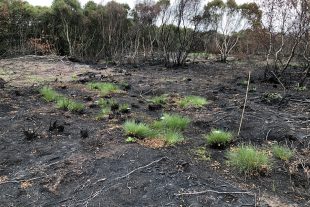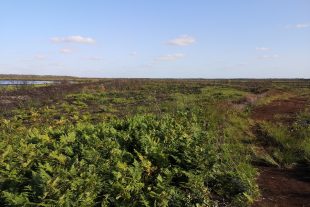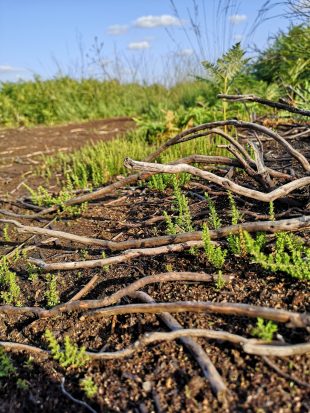
Hatfield Moors, part of the Humberhead Peatlands National Nature Reserve (NNR) near Doncaster, continues to recover from the serious wildfire that affected a large part of the Moors in May and June. Areas that were burnt continue to green over and the wildlife has resumed its familiar pattern across the NNR. Passage wading birds like Greenshank, Ringed Plover and Little Stint are moving through on their southerly migration and the first Pink-footed Geese are flying around the area as they return to their wintering grounds on the Humber.
Large parts of the NNR are open to visitors, but there are areas where we are still working to make the site safe. Where the fire became established amongst birch trees, the roots of some of the trees were burnt through by the smouldering peat, meaning that the trees either fell under their own weight or where they are still standing they may be unsafe. During the fire, we created some large firebreaks to stop the fire from reaching some neighbouring properties. We have started the long process of removing the accumulated woody material that was pushed to the side of the firebreaks by a bulldozer. This material needs to be pulled apart using an excavator and grab and then chipped, the resulting woodchip being reused to maintain some of the paths around the reserve. We are monitoring the recovery of the Moor and its wildlife in a variety of ways, including looking at the effects on beetles and keeping a record of habitat recovery through fixed-point photography.

Although a large area of the Hatfield Moors was affected by the fire, large parts within this area were not burnt since our work to restore the internationally rare bog habitat on the NNR has meant that large parts are very wet. The most heavily affected areas are those that are higher and dryer, including the routes of the old railway system that were used historically to transport peat off the site for processing and packaging for the horticultural trade. The restored wet areas become vegetated by more fire-resistant cottongrass and bog mosses, whereas the higher and dryer areas support the flammable mixture of heather and birch. It was the old railways that enabled this wildfire to spread rapidly in the dry and windy conditions that prevailed at the time.
Unfortunately, our changing climate means that the risk of wildfires on Hatfield Moor and elsewhere is increasing. We are continuing to work with our partners to review our Wildfire Response and Management Plans for the Humberhead Peatlands NNR. We envisage that in future the new firebreaks will be permanent features. We will also be looking to create smaller firebreaks on the old railways themselves to help ensure that any fire that is not put out in the very early stages is not able to spread so rapidly across the Moor.
I continue to urge people to respect the environment and follow the Countryside Code. In particular, please do not light fires or barbecues in the countryside in order to help support our emergency services and protect the environment.

About the site:
Hatfield Moors is owned and managed by Natural England. It’s one of two sites that make up the Humberhead Peatlands National Nature Reserve. The other site, Thorne Moor has not been affected. The location is usually a popular destination for hikers, dog walkers, runners or anyone wanting to relax in the beautiful, natural surroundings.
The site is a designated Special Protection Area and Special Area of Conservation. This means that it’s the home to a number of protected, and in some cases threatened, birds and wildlife. On this site that includes Nightjars, adders and a number of important plants and invertebrates. The site is also the largest area of lowland peat bog in England and work has been underway to restore it since 2014. Peatlands are particularly important carbon stores and restoring their condition will contribute to reducing carbon emissions.